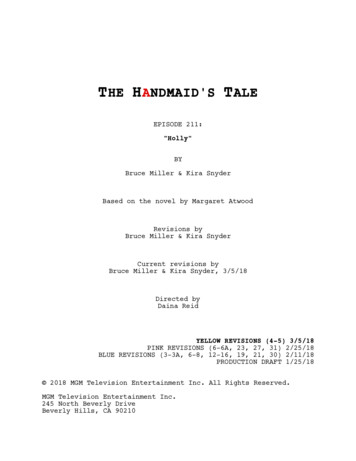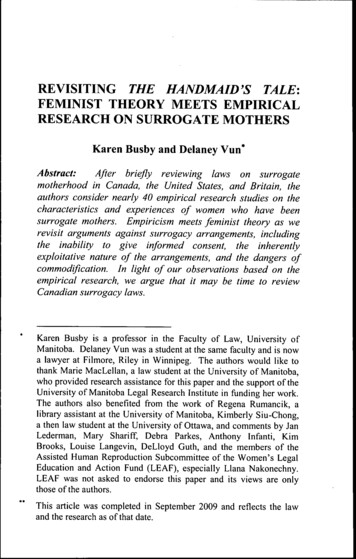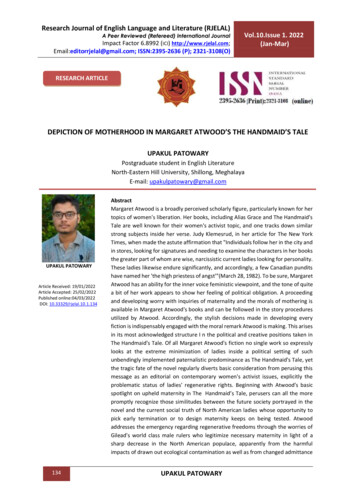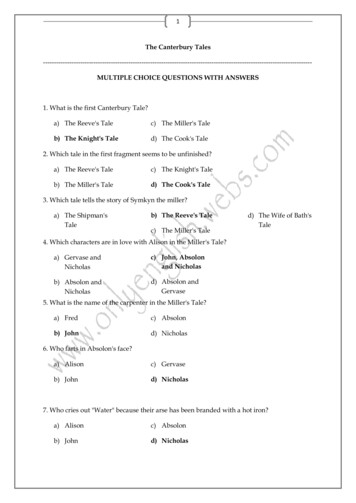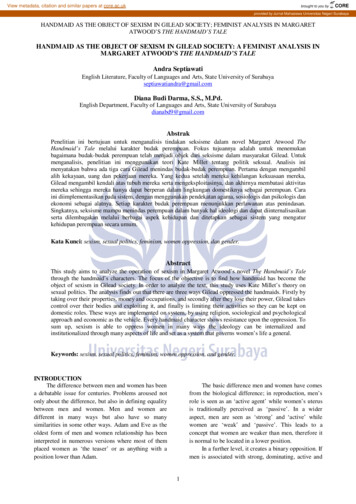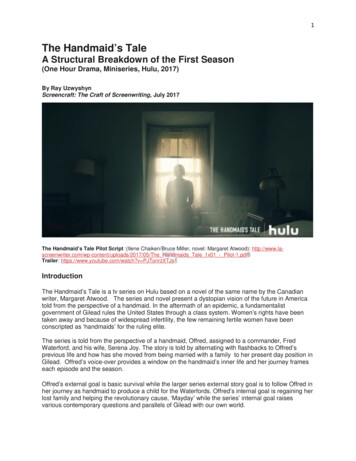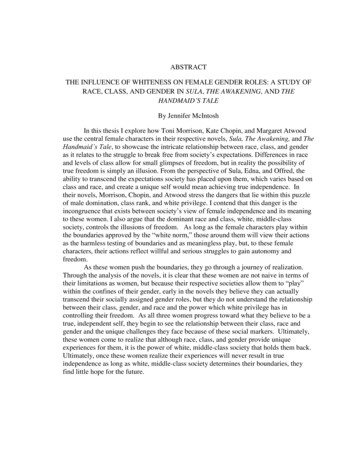
Transcription
ABSTRACTTHE INFLUENCE OF WHITENESS ON FEMALE GENDER ROLES: A STUDY OFRACE, CLASS, AND GENDER IN SULA, THE AWAKENING, AND THEHANDMAID’S TALEBy Jennifer McIntoshIn this thesis I explore how Toni Morrison, Kate Chopin, and Margaret Atwooduse the central female characters in their respective novels, Sula, The Awakening, and TheHandmaid’s Tale, to showcase the intricate relationship between race, class, and genderas it relates to the struggle to break free from society’s expectations. Differences in raceand levels of class allow for small glimpses of freedom, but in reality the possibility oftrue freedom is simply an illusion. From the perspective of Sula, Edna, and Offred, theability to transcend the expectations society has placed upon them, which varies based onclass and race, and create a unique self would mean achieving true independence. Intheir novels, Morrison, Chopin, and Atwood stress the dangers that lie within this puzzleof male domination, class rank, and white privilege. I contend that this danger is theincongruence that exists between society’s view of female independence and its meaningto these women. I also argue that the dominant race and class, white, middle-classsociety, controls the illusions of freedom. As long as the female characters play withinthe boundaries approved by the “white norm,” those around them will view their actionsas the harmless testing of boundaries and as meaningless play, but, to these femalecharacters, their actions reflect willful and serious struggles to gain autonomy andfreedom.As these women push the boundaries, they go through a journey of realization.Through the analysis of the novels, it is clear that these women are not naive in terms oftheir limitations as women, but because their respective societies allow them to “play”within the confines of their gender, early in the novels they believe they can actuallytranscend their socially assigned gender roles, but they do not understand the relationshipbetween their class, gender, and race and the power which white privilege has incontrolling their freedom. As all three women progress toward what they believe to be atrue, independent self, they begin to see the relationship between their class, race andgender and the unique challenges they face because of these social markers. Ultimately,these women come to realize that although race, class, and gender provide uniqueexperiences for them, it is the power of white, middle-class society that holds them back.Ultimately, once these women realize their experiences will never result in trueindependence as long as white, middle-class society determines their boundaries, theyfind little hope for the future.
To Jordan Landry, your incredible and unwavering support gave me the courage andstrength to persevere. You are a gift to the world of education.To Margaret Hostetler, Christine Roth, and Laura Jean Baker, your help through theprocess was invaluable.To all of my parents: Sue, Harry, Ed, Jeannette, M.C., Cecil, Dave, and Joann. Thank youlistening and caring.And to my amazing family, Bill, Kaegan, and Kinley, my success is the direct result ofyour understanding and love.ii
TABLE OF CONTENTSPageINTRODUCTION 1CHAPTER ONE: SULA .Maternal Influence Sula and Nel: Black and White .101832CHAPTER TWO: THE AWAKENING .White Privilege .The Culture of Race .Good-bye to Whiteness .44495762CHAPTER THREE: THE HANDMAID’S TALE .Imagery: Black and White .The Reproduction of White Society .Relationships and Whiteness .72788286CONCLUSION .99WORKS CITED .100iii
1INTRODUCTIONIn this thesis I explore how Toni Morrison, Kate Chopin, and Margaret Atwooduse the central female characters in their respective novels, Sula, The Awakening, and TheHandmaid’s Tale, to showcase the intricate relationship between race, class, and genderas it relates to the struggle to break free from society’s expectations. Differences in raceand levels of class allow for small glimpses of freedom, but in reality, the possibility oftrue freedom is simply an illusion. From the perspective of Sula, Edna, and Offred, theability to transcend the expectations society has placed upon them, which varies based onclass and race, and create a unique self would mean achieving true independence. Intheir novels, Morrison, Chopin, and Atwood stress the dangers that lie within this puzzleof male domination, class rank, and white privilege. I contend that this danger is theincongruence that exists between society’s view of female independence and its meaningto these women. I also that the dominant race and class, white, middle-class society,control these illusions of freedom. As long as the female characters play within theboundaries approved by the “white norm,” those around them will view their actions asthe harmless testing of boundaries and as meaningless play, but, to these femalecharacters, their actions reflect willful and serious struggles to gain autonomy andfreedom.As these women push the boundaries placed upon them, they go through ajourney of realization. Through the analysis of the novels, it is clear that these womenare not naive in terms of their limitations as women, but because their respective societies
2allow them to “play” within the confines of their gender, early in the novels they believethey can fully transcend their socially assigned gender roles, but they do not understandthe relationship between their class, gender, and race and the power which whiteprivilege has in controlling their freedom. As all three women progress toward what theybelieve to be a true, independent self, they begin to see the relationship between theirclass, race and gender and the unique challenges they face because of these socialmarkers. Ultimately, these women come to realize that although race, class, and genderprovide unique experiences for them, it is the power of white, middle-class society thatholds them back. Ultimately, once these women realize their experiences will never resultin true independence as long as white, middle-class society determines their boundaries,they find little hope for the future.The individuality of these characters’ experiences become apparent as each ofthem is able to experience small glimpses of freedom and moments of consciousness inwhich they realize their constraints. Although achieving true independence for thesewomen would be to transcend the barriers placed upon them by society, achieving a levelof conscious awareness also allows them to recognize whiteness’ influence and see whatmay lie beyond it even though they can never truly transcend it. This level of awarenesscreates a paradox within the text. The central female characters are able to see therestrictions placed upon them, they realize that those restrictions are upheld by whitesociety, and they challenge those boundaries placed upon them. Those realizations in andof themselves represent the “freeing” of their thinking. The paradox lies in the fact that
3they are able to free their thinking, but they will never able to fully and physicallytranscend the constraints place upon them.All three novels show a similar progression of consciousness in their centralfemale characters. In Toni Morrison’ Sula, Sula Peace and her best friend Nel Wrightrecognize as young girls that “they were neither white nor male, and that all freedom andtriumph was forbidden to them, they had set about creating something else to be” (52).Early on they recognize that being female and black puts them at a disadvantage socially,but they still feel that they can change how they are perceived and create unique selves.Sula and Nel are not aware of the real reason that society views them differently and asMorrison takes us through their lives, it becomes clear that their differences in classposition create different expectations for each of them. In the text, Sula is able to achievea conscious awareness of her restrictions due to race, and class. Morrison juxtaposes Sulaand Nel to show that they encounter different challenges and, conversely, experiencedifferent glimpses of freedom because of their different class positions. Although theirchallenges are different, the root cause always comes back to white society’s expectationsfor these women and the limits white society has placed upon them. With regard toMorrison’s text, I argue that Sula and Nel achieve levels of conscious awareness atcertain moments in the text, and they make different choices based on their race andclass, yet both women eventually see that white influence was the ultimate reason theycould not truly be independent and create “something else to be.”In Kate Chopin’s The Awakening, Edna Pontellier is aware that there have beenmany expectations placed upon her as a wife, mother, and upper-middle class woman, but
4as she progresses through the novel, she begins to step outside her upper-middle classwhite view and see that she experiences both privilege and restraint because of her classand race. Chopin begins Edna’s story when Edna is fully entrenched in her marriage andmotherhood, and immediately Chopin begins to showcase Edna’s leisure, which is a signof her class. On the surface, Edna’s story may seem to simply be about her class positionand her expectations as a wife and mother, but, as Edna begins to reject motherhood andwifehood, Chopin explores Edna’s lack of culture and uniqueness. Through a number ofexperiences, Edna becomes consciously aware of white, middle-class society’s grasp onher independence. Edna is able to step outside of her position as an upper-middle classwhite woman, and appreciate the uniqueness other classes and races possess. Ednaeventually challenges her fidelity and her class position, and she envisions “a new race ofbeings” (52). Like Sula, Edna recognizes that in order to break free, she must createsomething new entirely, and, for a while, she is allowed to resemble another race andclass (the black working class) and escape the grandeur that symbolizes her wealth.Ultimately, Edna realizes there is no “new race” nor can she become something differentthan what she represents: a pure, white wife and mother. She realizes that there is noescape from the white “race” and its control over her.In her dystopian novel, The Handmaid’s Tale, Margaret Atwood explores thelogical conclusion of the influences of whiteness that Sula and Edna experience in theirrespective novels. In Atwood’s text, Offred lives in a highly restrictive society whichlimits her dress, language, sexual partners, and more. Offred knows that she isexperiencing these restrictions due to her gender, but as she experiences life in Gilead,
5she begins to recognize, as does the reader, that Gilead is ultimately concerned aboutpreserving white society. Offred is in a unique position when compared to Sula and Nel.Offred’s consciousness leads to the realization that she had freedoms before the Gileadregime took over, now she has no freedom or independence, and, within this highlyrestrictive society, she strives to regain a sense of self once again. When she makes thechoice to “cross the invisible line” with Ofglen and engage in unapproved discourse shesays, “I steel myself” (217). Offred consciously prepares to make herself hard, like steel,but she also “steals” herself from the powers of Gilead and makes her own consciousdecision to engage in conversation with Ofglen. Throughout the novel, Offred becomesconsciously aware that she must partake in these small moments of freedom, and she alsobecomes aware that whiteness is the main influence of Gilead. Although there are clearindications of socioeconomic status and certain privileges for those in that class, theultimate goal of Gilead is to have a perfect, white society. Ultimately, Offred gains anunderstanding of the goals of Gilead and she, too, recognizes that she cannot escape theconfines of whiteness. Even when her options for the future look bleak, she is thrust intothe control of white men who determine where she is to go next and how she is to escapeGilead. She is never able to establish a unique self and experience true independence.I argue that these three seemingly unrelated novels are in fact connected becauseall three authors highlight the tangled puzzle of class, race, and gender and itsrelationship to white privilege. I contend that these authors consciously chose to use theirnovels to show that in some ways women can challenge the boundaries, but, once theycome too close to transcending the gender expectations placed upon them, white, middle-
6class, male-dominated society exerts its power and control and ultimately thrusts themout of their journey toward independence and back into a society that does not recognizenor accept their creation of a unique self.In this thesis, I analyze the texts from a feminist perspective and through the lensof whiteness studies. Contemporary feminist scholars, many of whom I will call upon inthis thesis, recognize the relationship between race, class, and gender and acknowledgethat women experience different challenges and small illusions of freedom based on theirrace and class. In her 2004 essay “Some Group Matters,” feminist scholar Patricia HillCollins addresses the importance of recognizing the different challenges women facebased on their race and class. She observes, “Because women are distributed acrossgroups formed within race-class intersectionality, gender raises different issues. Longstanding exclusionary practices that separate women by race, economic conditions,citizenship status, and ethnicity result in social groups that include women, organized viathese categories” (75). Collins notes that women are not separate social groups, butrather a part of larger socioeconomic and racial groups that experience differentlimitations and expectations based on their background. Feminist theorists in generalacknowledge that women’s race and class allow for different experiences, and, therefore,present unique struggles for each woman. I enter this conversation of race, class, andgender by acknowledging that these factors provide unique experiences for each woman,but I argue that whiteness has the most influences and white society ultimately decideshow far each woman can go depending on her race and class. Whiteness experts haveaddressed issues of race, and class, but have not fully addressed these issues in relation to
7gender roles, in this case, female independence. In this thesis, I bring all of these ideastogether through the analysis of the characters and imagery in Toni Morrison’s Sula, KateChopin’s The Awakening, and Margaret Atwood’s The Handmaid’s Tale and show howwhite society controls these women in the same way, yet with different boundaries basedon each woman’s race and class.I see a clear connection between Collins’ arguments and the foundations ofwhiteness studies. Whiteness studies as an interdisciplinary subject began to take shapeand gain recognition in the early 1990s. I base much of my discussion of whiteness onseveral seminal authors in the field including Richard Dyer, Ruth Frankenberg, PeggyMcIntosh, and Toni Morrison. I argue that middle -class white society, which representsthe majority, is ultimately in control of all three characters’ journeys towardindependence. As discussed, I see true independence as a woman’s ability to create anew self that is not defined by the limitations of traditional female roles, which wereoriginally socially constructed and continue to be enforced and maintained by whitesociety. Collins, too, sees a clear standard for the traditional family unit and women’splace within it. She states,Defined as a natural or biological arrangement based on heterosexual attraction, anormative and ideal family consists of a heterosexual couple who produce theirown biological children. Formed through a combination of marital and blood ties,the traditional family ideal views this nuclear unit as having a specific authoritystructure, arranged in this order: a father-head earning an adequate family wage, astay-at-home wife and mother, and children. (76)
8I see a direct correlation between Collins’ discussion of the “natural” and “traditional”family and Richard Dyer’s definition of whiteness as the “human norm.” Dyer contends,“As long as race is something only applied to non-white peoples, as long as white peopleare not racially seen and named, they/we function as a human norm. Other people areraced, we are just people” (1). Just as Collins defines the traditional, male-dominated,middle-class family unit as a socially constructed norm, Dyer sees whiteness as society’snormal and dominant race. Like Collins, Dyer sees the “white norm” as a restraining,preventive, and exclusive social norm. My “definition” of whiteness is based on Dyer’sargument. Dyer points to the basic idea that to define one’s race as white is to claimnormalcy. My discussion of the expectations placed upon women is based on Dyer’scontention that in modern society, whiteness is viewed as normalness, and, if a personidentifies themselves as one race or another, then they are identifying themselves as the“other,” as non-white, as a person outside of the societal norm. Peggy McIntosh,Associate Director of the Wellesley Centers for Women supports this discussion of therepresentation of whiteness. In her famous essay, “White Privilege and Male Privilege:A Personal Account of Coming to See Correspondences Through Work in Women'sStudies” McIntosh contends, “Whites are taught to think of their lives as morally neutral,normative, and average, and also ideal, so that when we work to benefit others, this isseen as work that will allow ‘them’ to be more like ‘us’” (78). McIntosh also recognizessociety’s assumption that white equals normal and that all non-whites wish to be“whiter,” allowing “them” to be more like “us.” Furthermore, McIntosh’s observationsshow how white privilege comes with the assumption that all people wish to be more like
9their white counterparts, and, by white society assimilating them into the “norm,” whitesociety is helping non-white society. With the assumption that whiteness equalsnormalness comes the misconception that all races long to be white rather than embracetheir unique culture.I bring Collins, Dyer, and McIntosh together and showcase a multi-facetedconnection; the assumptions that all non-whites long to be white, the idea that all womenhave a natural tendency to follow the path of the heterosexual wife and mother, and theillusion that all women benefit from and long to move up the socioeconomic scale aresocially constructed myths. As I will show, Morrison, Chopin, and Atwood clearly andbrilliantly depict the characters’ realization of whiteness’ influence and the realizationthat race, class, and gender work as an intricate web creating the self. As Sula, Edna, andOffred embark upon their journeys toward independence, their eyes are opened to realitythat as long as society still holds onto the beliefs and standards set by the dominant raceand class, they will never truly be able to be independent; they will never be able toescape the ideal heterosexual wife, mother, and caretaker roles set by white society. Atthe end of their journeys, these women realize there is no unique self, and there is noaccepted female role that falls between mother and whore; as far as society is concerned,they can only be one or the other. Morison, Chopin and Atwood use their central femalecharacters to demonstrate the repercussions of the socially constructed myths aboutwomen and their roles; furthermore, they use these female characters to show that nomatter a woman’s race or class position, her ability to achieve true independence willalways be controlled by white, middle-class society’s views of the norm.
10CHAPTER ONESULAIn her novel Sula, Toni Morrison weaves a tale of women’s freedoms andrestrictions through the lives of two black women, Nel Wright and Sula Peace. Her novelnot only tells the story of these women’s lives, but it also offers a glimpse inside theimpact of white society, class position, and gender inequality in a southern blackcommunity, Medallion (also referred to as the Bottom), in the 1940s. Morrison uses thegirls’ “coming of age” to showcase the impact which whiteness has on black women, andshe juxtaposes Nel and Sula’s social positions to elaborate on the complexity anduniqueness of their challenges to become independent. Morrison uses Sula to commenton the effects of gender and race expectations, and she outlines how these expectationscoupled with class directly influence and hinder Sula and Nel’s pursuits of independenceand unique selves that embrace difference rather than conformity.Critics have addressed many aspects of race, class and gender (as well as genderrelationships) in Morrison’s text, but my discussion will focus on the progression of Sulaand Nel as they journey though life aware of their restrictions as black women, andbecoming aware that whiteness has the most influence on their progression towardselfhood. In addition, my analysis shows that Morrison uses symbolism and imagery toshow the power of white society and how Sula and Nel become more and more aware ofthe fact that the barriers white society has placed upon them are different based upontheir social positions, but, ultimately, all the barriers are nearly impossible to break down.
11Furthermore, the influence of whiteness and the pressures to conform to that whichsociety identifies as standard female roles begins at home as mothers pass alongexpectations, or, in Sula’s case, do not pass along expectations, to conform to the norm.Women are continually urged to find power and contentment in the private sphere, butmen continue to hold power in the public sphere, which in turn continues the cycle ofwomen’s gender expectations and the power of white influence. This cycle is clearlyportrayed in Morrison’s text. Throughout their lives, Sula and Nel battle against anunrealistic standard of the ideal heterosexual wife and mother founded on the mythswhite society perpetuates. The standards on which Sula and Nel are judged are void ofany uniqueness related to their race, but rather founded on the principles of the white“norm.”In order to understand the present state of criticism as it relates to these topics andMorrison’s text, we must look at some of the arguments that preface my position, which Iwill expand upon in this chapter. One of the main foci of this thesis, in particular thischapter, is the influence of white society on the characters and its influence on therestrictions they encounter. Cynthia A. Davis addresses this topic in her article “Self,Society, and Myth in Toni Morrison's Fiction.” Davis argues,They [Sula and Nel] are also black women in a society whose female ideal is awhite "doll baby," blonde and blue-eyed Shirley Temple. Even if they accept theirreification they will always be inadequate; the black woman is "the antithesis ofAmerican beauty." No efforts at disguise will make them into the images they
12learn to admire. Defined as the Other, made to be looked at, they can never satisfythe gaze of society. (329)Davis speaks directly about Sula in relation to the “white equals normal” influence.Furthermore, Davis overtly points out that Sula and Nel will never “satisfy the gaze ofsociety” because they are black. Davis’ observation mirrors Richard Dyer’s contentionregarding the dangers of white privilege: If whiteness equals normalness then all racesmust strive to achieve a likeness to whiteness in order to be accepted. Although I fullyagree with Davis’ position, and subsequently Dyer’s, I see a greater impact on the girls’independence in Sula. Davis’ observation is just one piece of a complex puzzle of genderexpectations, white influences, and class struggles. Nel and Sula struggle to definethemselves in a community grounded in segregation and separation. Whiteness incombination with social position creates an unrealistic expectation to belong to a culturethat mirrors the white social norm and is void of the unique traditions of the blackculture. Furthermore, these expectations support the ideals associated with female beauty.Not only does white society try to strip Sula and Nel of the uniqueness of black roots, butit also reinforces the ideals of the female body to which Sula and Nel are constantlycompared.This discussion of Sula is by no means a universal representation of how “nonwhite” women are impacted throughout the United States, but the Bottom does serve asan interesting subject and representation of how race, class, and gender are representedand perceived within a community. In her essay, “Some Group Matters,” Patricia Hill
13Collins discusses the relationship between the African-American community and theAfrican-American individual. I base my observations of Morrison’s text and my analysisof Morrison’s societal commentary on Collins’ theory of African Americanindividualism. She contends,One might ask whether African-Americans “live under economic conditions ofexistence that separate their mode of life, their interests, their culture from thoseof other classes” or, alternatively, whether African-Americans continue to bearthe intergenerational costs associated with the denial of citizenship stemmingfrom their being branded “a subordinate and inferior class of beings.” ForAfrican-Americans, group personality is determined less by theoretical categoriesconstructed within assumptions of distinct discourses of class or race, and moreby actual lived Black experience (72).Collins’ discussion is imperative to the discussion of Sula in terms of class, race andgender because it is clear that the individual experience trumps assumptive theories onclass and race. I contend that Sula and Nel’s individual experiences, or lack thereof, withwhite society creates their personality and their path. In conjunction with Collins’argument, I content that Sula and Nel have unique experiences with gender roles andrelationships based on their family make-up and individual social position. Theirdistance from or proximity to the center of influence, which in the Bottom is whitesociety, drives their individual actions. The lower their class position, the less influencedthey are by white society because there is less pressure to conform. As I will show in this
14chapter, Nel’s family is most closely identified as a middle-class, black family as it wouldbe defined in Medallion. As a result, Nel’s mother Helene strives to resemble the typicalwhite, middle-class wife and mother. She represents the classic heterosexual wife andmother. Sula, on the other hand, comes from a lower-class home which represents theantithesis of the classic middle-class home. Sula’s mother and grandmother have severalmale lovers, none of whom live in the Peace home, and, on the surface, they care verylittle about their resemblance to a white, middle-class home. As young women, Sula andNel strive to be unique and to “find something else to be,” yet their class differencescreate distinct challenges and opportunities for independence. Neither woman finds theprocess of challenging society easy and they both experience challenges because of theirrace. Whiteness seeps into Sula’s and Nel’s lives and serves as an outside forceattempting to crush their uniqueness, but their reaction to this force is based on theirclass, and that is what ultimately splits their paths in life.Morrison not only uses Sula and Nel to represent the power of whiteness, theinfluence of class, and the uniqueness that comes with individual experience, she alsouses the very essence of their home, the Bottom, to show how all these things cometogether. The Bottom serves as an interesting parallel between the personal identitiesCollins references and the cultural personality of a black community. As a piece of landgiven to a freed slave whose master coined it as “(It’s) the bottom of heaven-best landthere is” (5). Morrison describes,
15 it wasn’t a town anyway; just a neighborhood where on quiet days people in thevalley houses could hear singing sometimes, banjos sometimes, and, if a valleyman happened to have business up in those hills-collecting rent or insurancepayment-he might see a woman in a flowered dress doing a bit of a cakewalk, abit of black bottom, a bit of “messing around” to the lively notes of the mouthorgan. Her bare feet would raise the saffron dust that floated down on the coverallsand bunion-split shoes of the man breathing in and out of his harmonica. Theblack people watching her would laugh and rub their knees, and it would be easyfor the valley man to hear the laughter and not notice the adult pain that restedsomewhere under the eyelids. (4)Morrison’s rich description of the Bottom paints a vivid picture of the personalities thatreside there, and this passage describes how many white visitors may see only onedimension of the residents of this neighborhood. The man from the valley does notrecognize that within this seemingly joyous community there is pain and struggle. Theoutside visitors do not recognize all that encompassed the people of the Bottom. Theindividual experiences of the community members create a unique setting and culture.Throughout the novel, whiteness seeps into the Bottom and Morrison clearly shows howwhiteness ultimately crushes the uniqueness of the Bottom, a community created by itsunique individuals and their experiences. Morrison consciously begins the novel bystating that the Bottom no longer exists: “In that place, where they tore the nightshadeand blackberry patches from their roots to make room for the Medallion City GolfCourse, there was once a neighbo
HANDMAID'S TALE By Jennifer McIntosh In this thesis I explore how Toni Morrison, Kate Chopin, and Margaret Atwood use the central female characters in their respective novels, Sula, The Awakening, and The Handmaid's Tale, to showcase the intricate relationship between race, class, and gender

